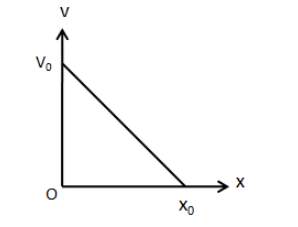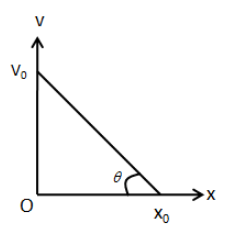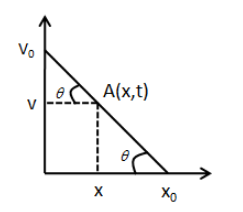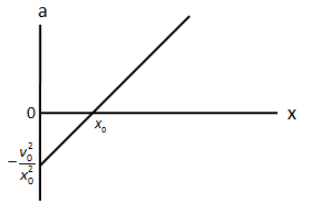
The velocity-displacement graph of a particle is shown in figure.
a) Write the relation between v and x.
b) Obtain the relation between acceleration and displacement and plot it.


Answer
556.5k+ views
Hint:Express the angle made by the straight line with the horizontal axis. Then assume the position of the particle at any point of the straight line and then express the angle made by this straight line with the horizontal axis. Comparing the two equations, we will get the relation between v and x. The derivative of velocity with respect to time is the acceleration of the particle.
Complete step by step answer:
(a) We have given the initial velocity \[{v_0}\] and displacement \[{x_0}\] at time \[t = 0\]. We can redraw the above figure as,

From the above figure, we can express \[\tan \theta \] as,
\[\tan \theta = \dfrac{{{v_0}}}{{{x_0}}}\] …… (1)
Now, we assume at any instant of time, the particle has velocity v and displacement x. The position of the particle is shown by the point A in the following figure.

We can express \[\tan \theta \] as,
\[\tan \theta = \dfrac{{{v_0} - v}}{x}\] …… (2)
From equation (1) and (2), we can write,
\[\dfrac{{{v_0}}}{{{x_0}}} = \dfrac{{{v_0} - v}}{x}\]
\[ \Rightarrow {v_0}x = {v_0}{x_0} - v{x_0}\]
\[ \Rightarrow v = \dfrac{1}{{{x_0}}}\left( {{v_0}{x_0} - {v_0}x} \right)\]
\[ \therefore v = - \dfrac{{{v_0}}}{{{x_0}}}x + {v_0}\] …… (3)
This is the relation between v and x.
(b) We know that the acceleration is the derivative of velocity of the particle. Therefore, we can write.
\[a = \dfrac{{dv}}{{dt}}\]
We have the expression for velocity obtained in part (a) of the solution. Therefore, the acceleration of the particle is,
\[a = \dfrac{d}{{dt}}\left( { - \dfrac{{{v_0}}}{{{x_0}}}x + {v_0}} \right)\]
\[ \Rightarrow a = - \dfrac{{{v_0}}}{{{x_0}}}\dfrac{{dx}}{{dt}} + \dfrac{d}{{dt}}\left( {{v_0}} \right)\]
\[ \Rightarrow a = - \dfrac{{{v_0}}}{{{x_0}}}v\]
Using equation (3), we can rewrite the above equation as,
\[a = - \dfrac{{{v_0}}}{{{x_0}}}\left( { - \dfrac{{{v_0}}}{{{x_0}}}x + {v_0}} \right)\]
\[ \therefore a = \dfrac{{v_0^2}}{{x_0^2}}x - \dfrac{{v_0^2}}{{{x_0}}}\]
From the above expression, if the displacement of the particle x is zero. Then the acceleration of the particle is \[ - \dfrac{{v_0^2}}{{{x_0}}}\]. Also, the acceleration of the particle increases linearly with respect to the position of the particle. Therefore, we can plot the graph of acceleration and displacement as,

The acceleration is zero when the displacement \[x = {x_0}\] .
Note: In equation (1) and (2), the angle \[\theta \] is the same since it is the angle made by the same line with the horizontal axis. Always remember, the derivative of displacement with respect to time is the velocity and the derivative of velocity with respect to time is the acceleration. In the acceleration-displacement plot, the acceleration becomes zero at initial position \[{x_0}\] which can be found by assuming \[\dfrac{{v_0^2}}{{x_0^2}}x = \dfrac{{v_0^2}}{{{x_0}}}\] and solving for x.
Complete step by step answer:
(a) We have given the initial velocity \[{v_0}\] and displacement \[{x_0}\] at time \[t = 0\]. We can redraw the above figure as,

From the above figure, we can express \[\tan \theta \] as,
\[\tan \theta = \dfrac{{{v_0}}}{{{x_0}}}\] …… (1)
Now, we assume at any instant of time, the particle has velocity v and displacement x. The position of the particle is shown by the point A in the following figure.

We can express \[\tan \theta \] as,
\[\tan \theta = \dfrac{{{v_0} - v}}{x}\] …… (2)
From equation (1) and (2), we can write,
\[\dfrac{{{v_0}}}{{{x_0}}} = \dfrac{{{v_0} - v}}{x}\]
\[ \Rightarrow {v_0}x = {v_0}{x_0} - v{x_0}\]
\[ \Rightarrow v = \dfrac{1}{{{x_0}}}\left( {{v_0}{x_0} - {v_0}x} \right)\]
\[ \therefore v = - \dfrac{{{v_0}}}{{{x_0}}}x + {v_0}\] …… (3)
This is the relation between v and x.
(b) We know that the acceleration is the derivative of velocity of the particle. Therefore, we can write.
\[a = \dfrac{{dv}}{{dt}}\]
We have the expression for velocity obtained in part (a) of the solution. Therefore, the acceleration of the particle is,
\[a = \dfrac{d}{{dt}}\left( { - \dfrac{{{v_0}}}{{{x_0}}}x + {v_0}} \right)\]
\[ \Rightarrow a = - \dfrac{{{v_0}}}{{{x_0}}}\dfrac{{dx}}{{dt}} + \dfrac{d}{{dt}}\left( {{v_0}} \right)\]
\[ \Rightarrow a = - \dfrac{{{v_0}}}{{{x_0}}}v\]
Using equation (3), we can rewrite the above equation as,
\[a = - \dfrac{{{v_0}}}{{{x_0}}}\left( { - \dfrac{{{v_0}}}{{{x_0}}}x + {v_0}} \right)\]
\[ \therefore a = \dfrac{{v_0^2}}{{x_0^2}}x - \dfrac{{v_0^2}}{{{x_0}}}\]
From the above expression, if the displacement of the particle x is zero. Then the acceleration of the particle is \[ - \dfrac{{v_0^2}}{{{x_0}}}\]. Also, the acceleration of the particle increases linearly with respect to the position of the particle. Therefore, we can plot the graph of acceleration and displacement as,

The acceleration is zero when the displacement \[x = {x_0}\] .
Note: In equation (1) and (2), the angle \[\theta \] is the same since it is the angle made by the same line with the horizontal axis. Always remember, the derivative of displacement with respect to time is the velocity and the derivative of velocity with respect to time is the acceleration. In the acceleration-displacement plot, the acceleration becomes zero at initial position \[{x_0}\] which can be found by assuming \[\dfrac{{v_0^2}}{{x_0^2}}x = \dfrac{{v_0^2}}{{{x_0}}}\] and solving for x.
Recently Updated Pages
Why are manures considered better than fertilizers class 11 biology CBSE

Find the coordinates of the midpoint of the line segment class 11 maths CBSE

Distinguish between static friction limiting friction class 11 physics CBSE

The Chairman of the constituent Assembly was A Jawaharlal class 11 social science CBSE

The first National Commission on Labour NCL submitted class 11 social science CBSE

Number of all subshell of n + l 7 is A 4 B 5 C 6 D class 11 chemistry CBSE

Trending doubts
What is meant by exothermic and endothermic reactions class 11 chemistry CBSE

10 examples of friction in our daily life

One Metric ton is equal to kg A 10000 B 1000 C 100 class 11 physics CBSE

1 Quintal is equal to a 110 kg b 10 kg c 100kg d 1000 class 11 physics CBSE

Difference Between Prokaryotic Cells and Eukaryotic Cells

What are Quantum numbers Explain the quantum number class 11 chemistry CBSE




